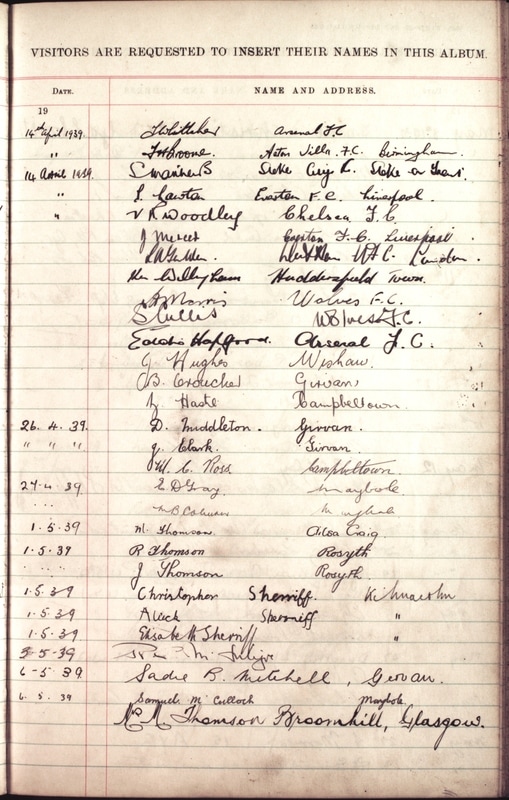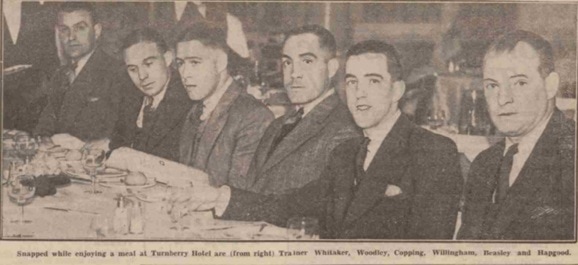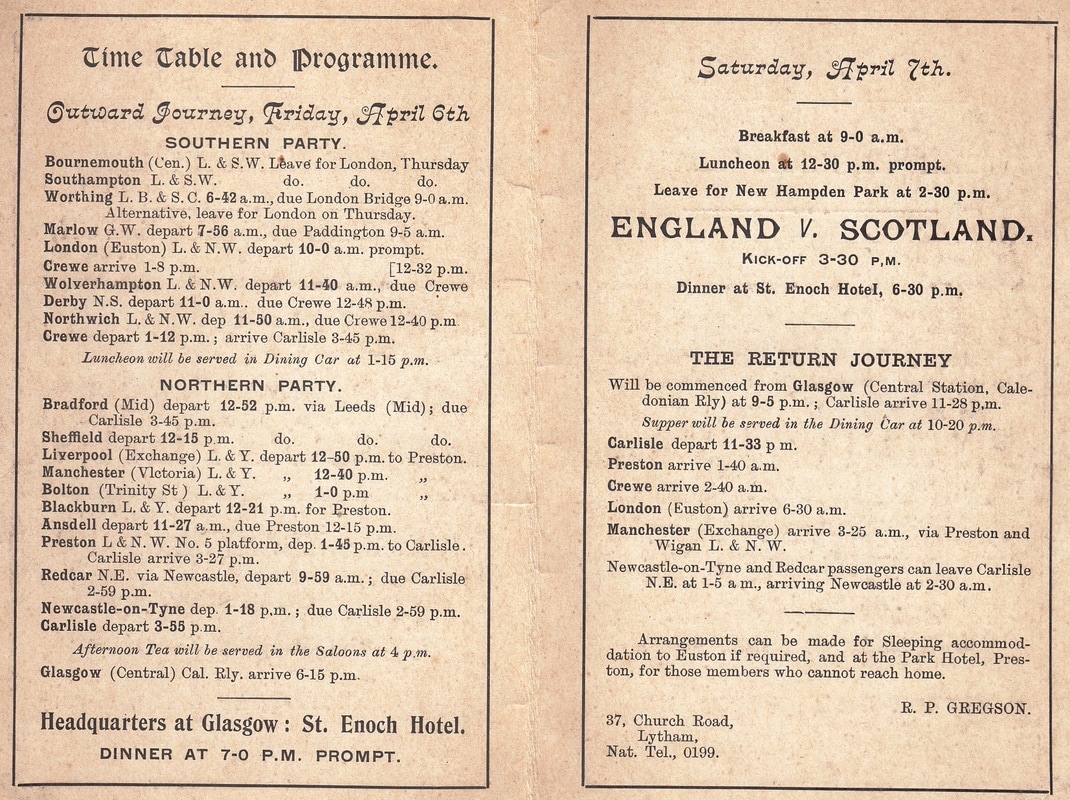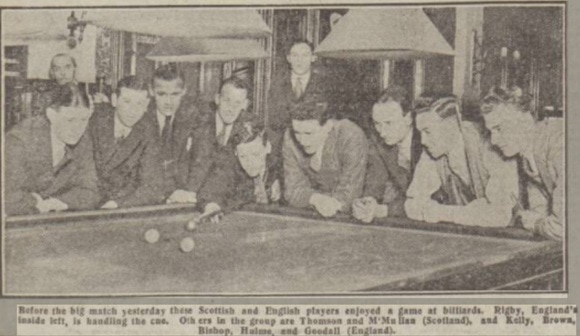It wasn’t always like that, though. We’ve been taking a dip into the archives to see how the players used to fill their time before the big match, and have found some surprising diversions which kept them occupied.
First, Douglas Gorman tells the story of a magnificent signed sheet from the Turnberrry Lighthouse, then Andy Mitchell relates a few anecdotes of past visits.
As they quickly transferred to a motor bus, Stanley Rous, FA Secretary, retorted 'We have a grand team and I am confident that we will win' and they travelled the twenty miles to their pre-match base at the Turnberry Hotel on the Ayrshire coast. Tom Whittaker of Arsenal, trainer to the team, reported that his eleven was fighting fit. At this time the Football Association did not, and indeed would not, appoint a manager for its international team but Rous understood the need for proper preparation and probably worked with Whittaker to get the team together for a full day before the game. In earlier years some England teams had simply arrived in Glasgow on the Friday night.
However, their preparation did not extend to packing a spare kit. The rain fell so heavily on Saturday that a drenched team needed to change their shirts, and had to borrow replacements from Queen's Park for the second half.
This was one of the first all-ticket matches at Hampden Park and apparently when SFA President Douglas Bowie travelled from Ayr to welcome the visitors at Turnberry his first question to Will Cuff, Everton Chairman and FA Vice President, was did he have any tickets to spare!
On the Friday the English team had the opportunity to relax and paid a visit to the Turnberry Lighthouse. We know this as eleven members of the party signed the visitors’ book, including some of the most famous names in English football: Stanley Matthews, Tommy Lawton, Stan Cullis, Eddie Hapgood among them. Also on the page are Tom Whittaker, Frank Broome (a travelling reserve), Vic Woodley, Joe Mercer, Len Goulden, Ken Willingham and Bill Morris.
Not all the players signed, and perhaps they did not go: the signatures of Willie Hall, Pat Beasley (a late substitute for Eric Brook of Manchester City), Wilf Copping (the other reserve) and Stanley Rous do not appear. Hall was a keen golfer so that may explain his absence, while Rous would have had administrative details to attend to, and indeed had to provide a late substitute for a talk he was due to give to Glasgow referees.
Curiously, Stanley Matthews signed the visitors' book for a second time when he returned, this time with his family, in 1947.
The Turnberry Lighthouse visitors’ book is preserved in the Northern Lighthouse Board archive, which is now held at the National Records of Scotland in Edinburgh. The former keepers’ accommodation is now a luxury retreat in the Trump empire, which would take a footballer’s salary to hire at a reported £7,000 a night, while the lighthouse itself remains an important aid to navigation in the Firth of Clyde.
In 1939, over 40,000 England supporters reportedly travelled to the match, with the London Midland & Scottish Railway (LMS) running 33 special trains for 16,000 supporters, including 600 who 'invaded' Ardrossan early on Saturday morning on two excursions organised by Sheffield and Manchester newspapers.
Each train had two kitchens which served supper on departure, breakfast on arrival at Ardrossan and, after a stroll around the town, lunch en route to King’s Park station near Hampden. It was all rounded off by dinner on the return journey. The on-board darts competition to pass the time seemed a risky endeavour!
They squeezed into a packed Hampden and had an outing to remember, as England bounced back from a half-time deficit to win the match through Tommy Lawton’s late header. At the time it was a rare triumph for the visitors, but it would be 1962 before the next Scotland win at Hampden over the old enemy.
Saturday 15 April 1939
Hampden Park, Glasgow (149,269)
Scotland 1 (Dougal 20), England 2 (Beasley 67, Lawton 88).
Scotland: Jerry Dawson (Rangers); Jimmy Carabine (Third Lanark) and George Cummings (Aston Villa); Bill Shankly (Preston North End), Bobby Baxter (captain, Middlesbrough) and Sandy McNab (West Bromwich Albion); Alex McSpadyen (Partick Thistle), Tommy Walker (Heart of Midlothian), Jimmy Dougal (Preston North End), Alex Venters (Rangers) and Jackie Milne (Middlesbrough).
England: Vic Woodley (Chelsea); Bill Morris (Wolverhampton Wanderers) and Eddie Hapgood (captain, Arsenal); Ken Willingham (Huddersfield Town), Stan Cullis (Wolverhampton Wanderers) and Joe Mercer (Everton); Stanley Matthews (Stoke City), Willie Hall (Tottenham Hotspur), Tommy Lawton (Everton), Len Goulden (West Ham United) and Pat Beasley (Huddersfield Town).
Referee: William R Hamilton (Belfast)
The Ayrshire coast remained a popular training base, for both countries, from the 1920s to the 1950s. The English generally stayed at Troon, sometimes arriving as early as Wednesday evening, and trained at Somerset Park in Ayr. The Scotland team base was not far away at the Marine Hotel in Largs, with training sessions at the local junior team’s Barrfield Park.
There was no time to hang around. The Saturday schedule included lunch at 12.30, departure from the hotel at 2.30, kick-off at 3.30, and the post-match dinner back at the hotel at 6.30. The train south departed Glasgow Central just after 9pm, and dropped people off through the night at various stations en route to London where it arrived at 6.30 am. For those fearful a sleepless night, 'Arrangements can be made for sleeping accommodation to Euston if required, and at the Park Hotel, Preston, for those members who cannot reach home.'
The next visit in 1908 saw a complete change of pace. The England team stayed at Dunblane Hydro, where former Scotland international Robert Christie (now a local architect) was delegated to look after them and was ‘assiduous in seeing to their comfort and fraternising with them.’ His programme for the guests included a visit to Dunblane Cathedral, where the players and officials were entertained by an organ recital. Changed days! But they must have enjoyed it as the team returned to Dunblane in 1910.
It was not just the players who enjoyed spending time in Scotland. We often think of the Tartan Army excursions down south, but it was the same in the other direction. The mass invasion by visiting England fans started early in the century and continued long after the War. In 1956, for example, there were 16 special trains from England, not to mention 11 plane-loads from London and Birmingham and hundreds of buses.
As a final comment, have a read of my article about the Scots who felt at home in London, published in the Scotsman in August 2013: http://www.scotsman.com/sport/football/scots-footballers-history-with-london-1-3039856




 RSS Feed
RSS Feed